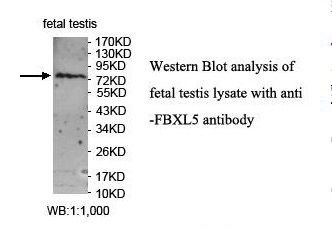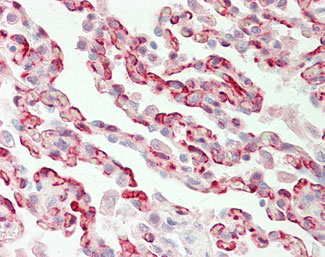FBXL5 / FBL5 Antibody (aa510-691)
Rabbit Polyclonal Antibody
- SPECIFICATION
- CITATIONS
- PROTOCOLS
- BACKGROUND

Application
| WB, IHC-P, E |
|---|---|
| Primary Accession | Q9UKA1 |
| Reactivity | Human |
| Host | Rabbit |
| Clonality | Polyclonal |
| Calculated MW | 79kDa |
| Dilution | ELISA (1:20000-1:80000), IHC-P (10 µg/ml), WB (1:1000-1:2000) |
| Gene ID | 26234 |
|---|---|
| Other Names | F-box/LRR-repeat protein 5, F-box and leucine-rich repeat protein 5, F-box protein FBL4/FBL5, p45SKP2-like protein, FBXL5, FBL4, FBL5, FLR1 |
| Target/Specificity | Human FBXL5. |
| Reconstitution & Storage | Store at -20°C for up to one year. |
| Precautions | FBXL5 / FBL5 Antibody (aa510-691) is for research use only and not for use in diagnostic or therapeutic procedures. |
| Name | FBXL5 |
|---|---|
| Synonyms | FBL4, FBL5, FLR1 |
| Function | Component of some SCF (SKP1-cullin-F-box) protein ligase complex that plays a central role in iron homeostasis by promoting the ubiquitination and subsequent degradation of IREB2/IRP2 (PubMed:19762596, PubMed:19762597). The C-terminal domain of FBXL5 contains a redox-sensitive [2Fe-2S] cluster that, upon oxidation, promotes binding to IRP2 to effect its oxygen-dependent degradation (PubMed:32126207). Under iron deficiency conditions, the N-terminal hemerythrin-like (Hr) region, which contains a diiron metal center, cannot bind iron and undergoes conformational changes that destabilize the FBXL5 protein and cause its ubiquitination and degradation (PubMed:19762596, PubMed:19762597). When intracellular iron levels start rising, the Hr region is stabilized (PubMed:19762596, PubMed:19762597). Additional increases in iron levels facilitate the assembly and incorporation of a redox active [2Fe-2S] cluster in the C- terminal domain (PubMed:32126207). Only when oxygen level is high enough to maintain the cluster in its oxidized state can FBXL5 recruit IRP2 as a substrate for polyubiquination and degradation (PubMed:32126207). Promotes ubiquitination and subsequent degradation of the dynactin complex component DCTN1 (PubMed:17532294). Within the nucleus, promotes the ubiquitination of SNAI1; preventing its interaction with DNA and promoting its degradation (PubMed:24157836). Negatively regulates DNA damage response by mediating the ubiquitin- proteasome degradation of the DNA repair protein NABP2 (PubMed:25249620). |
| Cellular Location | Cytoplasm, perinuclear region. Nucleus |

Thousands of laboratories across the world have published research that depended on the performance of antibodies from Abcepta to advance their research. Check out links to articles that cite our products in major peer-reviewed journals, organized by research category.
info@abcepta.com, and receive a free "I Love Antibodies" mug.
Provided below are standard protocols that you may find useful for product applications.
Background
Component of some SCF (SKP1-cullin-F-box) protein ligase complex that plays a central role in iron homeostasis by promoting the ubiquitination and subsequent degradation of IREB2/IRP2. Upon high iron and oxygen level, it specifically recognizes and binds IREB2/IRP2, promoting its ubiquitination and degradation by the proteasome. Promotes ubiquitination and subsequent degradation of DCTN1/p150-glued.
References
Winston J.T.,et al.Curr. Biol. 9:1180-1182(1999).
Ilyin G.P.,et al.Genomics 67:40-47(2000).
Shimbara N.,et al.Submitted (APR-1999) to the EMBL/GenBank/DDBJ databases.
Ota T.,et al.Nat. Genet. 36:40-45(2004).
Bechtel S.,et al.BMC Genomics 8:399-399(2007).
If you have used an Abcepta product and would like to share how it has performed, please click on the "Submit Review" button and provide the requested information. Our staff will examine and post your review and contact you if needed.
If you have any additional inquiries please email technical services at tech@abcepta.com.













 Foundational characteristics of cancer include proliferation, angiogenesis, migration, evasion of apoptosis, and cellular immortality. Find key markers for these cellular processes and antibodies to detect them.
Foundational characteristics of cancer include proliferation, angiogenesis, migration, evasion of apoptosis, and cellular immortality. Find key markers for these cellular processes and antibodies to detect them. The SUMOplot™ Analysis Program predicts and scores sumoylation sites in your protein. SUMOylation is a post-translational modification involved in various cellular processes, such as nuclear-cytosolic transport, transcriptional regulation, apoptosis, protein stability, response to stress, and progression through the cell cycle.
The SUMOplot™ Analysis Program predicts and scores sumoylation sites in your protein. SUMOylation is a post-translational modification involved in various cellular processes, such as nuclear-cytosolic transport, transcriptional regulation, apoptosis, protein stability, response to stress, and progression through the cell cycle. The Autophagy Receptor Motif Plotter predicts and scores autophagy receptor binding sites in your protein. Identifying proteins connected to this pathway is critical to understanding the role of autophagy in physiological as well as pathological processes such as development, differentiation, neurodegenerative diseases, stress, infection, and cancer.
The Autophagy Receptor Motif Plotter predicts and scores autophagy receptor binding sites in your protein. Identifying proteins connected to this pathway is critical to understanding the role of autophagy in physiological as well as pathological processes such as development, differentiation, neurodegenerative diseases, stress, infection, and cancer.



